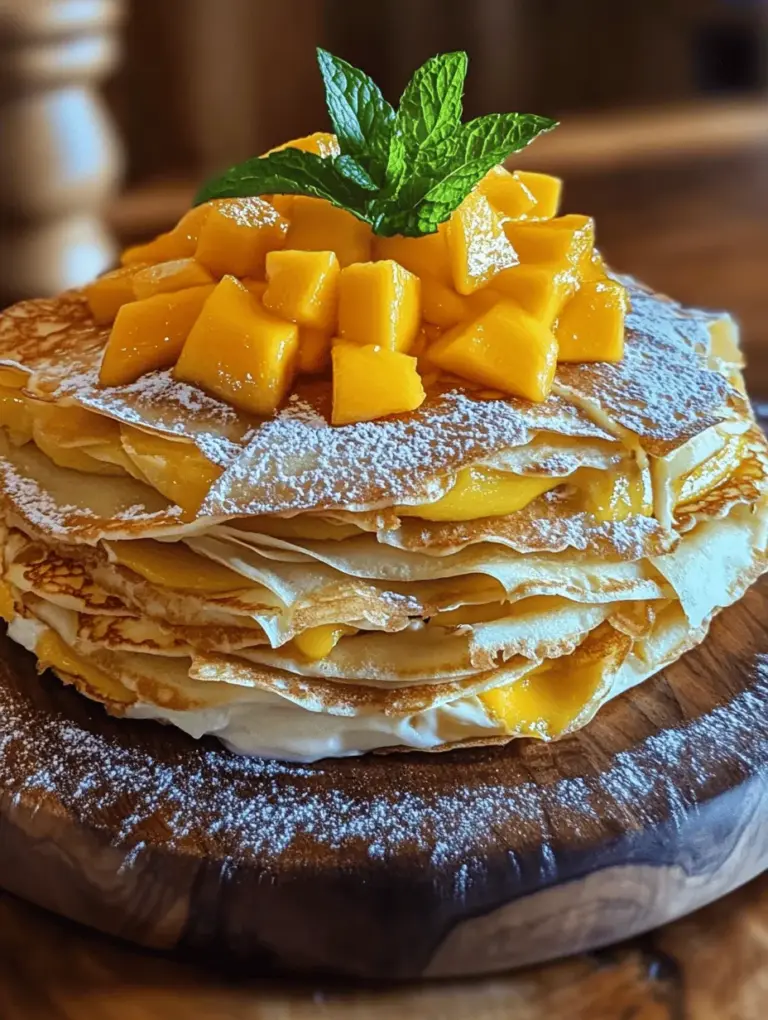Introduction
Welcome to the world of tropical indulgence with our delightful Mango Crepe Cake! This visually stunning dessert, with its delicate layers of thin crepes and luscious mango filling, is sure to impress both your taste buds and your guests. The Mango Crepe Cake combines the elegance of French patisserie with the vibrant, sweet flavors of tropical mangoes, making it a perfect centerpiece for any celebration or a simple treat for yourself.
Crepe cakes have gained immense popularity in dessert culture over the past few years, captivating food enthusiasts with their unique presentation and taste. Unlike traditional cakes, which are typically baked in a single pan and sliced into portions, crepe cakes are made by layering numerous thin crepes with a filling in between. This innovative approach creates a light and airy dessert that melts in your mouth, offering an entirely different experience than the classic cake.
Mangoes, often referred to as the “king of fruits,” elevate this dessert to new heights. Not only are they delicious, but they also bring a wealth of health benefits. Rich in vitamins A and C, mangoes boost immunity and promote healthy skin while providing a refreshing taste that complements the delicate crepes beautifully. In this recipe, we will guide you step-by-step in creating your very own Mango Crepe Cake, allowing you to enjoy this delightful treat and impress your family and friends.
Understanding Crepe Cakes
Crepe cakes are a fascinating fusion of culinary techniques that have their roots in French cuisine. A crepe, a thin pancake made from a batter of flour, eggs, and milk, serves as the foundation for this dessert. The history of crepes dates back to the 13th century in Brittany, France, where they were made from buckwheat flour. Over time, crepes have evolved, and today they are enjoyed in various forms around the globe.
In the realm of desserts, crepe cakes stand out due to their unique construction. Unlike traditional cakes, which feature a baked sponge or batter, crepe cakes are composed of multiple layers of crepes, each separated by a filling. This distinct layering technique creates a diverse texture, allowing the flavors to meld beautifully while providing a lightness that is often missing in denser cake varieties. The result is a dessert that is not only visually appealing but also a delightful sensory experience, as each slice reveals the intricate layers within.
The importance of layering in crepe cakes cannot be overstated. Each crepe contributes to the overall texture, creating a soft and creamy mouthfeel when combined with the filling. Additionally, the layers help to balance flavors, ensuring that every bite is a harmonious blend of sweetness and richness. This unique characteristic sets crepe cakes apart, making them a cherished choice for those looking to indulge in something truly special.
The Allure of Mangoes
Mangoes are not just delicious; they are also packed with nutritional benefits that make them a powerhouse fruit. Each juicy bite is rich in vitamins, minerals, and antioxidants, making mangoes a fantastic addition to any diet. They are particularly high in vitamin C, which supports the immune system and promotes healthy skin. Additionally, mangoes contain vitamin A, which is essential for eye health, and dietary fiber that aids in digestion.
When it comes to flavor profiles, there are many varieties of mangoes to choose from, each offering a unique taste experience. Some popular types include the Alphonso, known for its rich sweetness and creamy texture, the Haden, which has a tropical, aromatic flavor, and the Tommy Atkins, appreciated for its balanced sweetness and tang. Each variety brings its own charm to the Mango Crepe Cake, enhancing the dessert’s overall appeal.
The vibrant, sweet, and tangy flavor of mangoes makes them an ideal choice for desserts. Their natural sweetness allows for a reduced need for added sugars, while their juicy texture complements the delicate crepes perfectly. Moreover, mangoes have a cultural significance in many cuisines around the world, celebrated for their versatility and flavor. From Indian desserts to Southeast Asian dishes, mangoes are beloved for their ability to elevate any recipe they touch.
Ingredients Breakdown
To create a stunning Mango Crepe Cake, it is essential to have the right ingredients that work harmoniously together. Let’s dive into the key components needed for this delightful dessert.
Ingredients for the Crepes
– All-purpose flour: The base of the crepe batter, providing structure and texture.
– Eggs: Essential for binding the ingredients and adding richness.
– Milk: Contributes to the creaminess of the batter and helps achieve the desired thin consistency.
– Butter: Adds flavor and moisture to the crepes.
– Salt: Enhances the overall flavor of the crepes.
Making the crepe batter requires a careful balance of these ingredients to achieve a smooth and pourable consistency. The batter should be thin enough to spread easily in the pan while still holding together when cooked.
Mango Filling Components
– Ripe mangoes: The star of the show! Choose sweet and juicy mangoes for the best flavor.
– Whipped cream: Adds a light and airy texture to the filling, making it rich yet not overwhelming.
– Cream cheese or mascarpone: Provides a creamy base for the filling, adding depth and richness.
– Vanilla extract: Enhances the overall flavor, complementing the sweetness of the mangoes.
Optional ingredients include gelatin, which can be used to stabilize the filling, ensuring it holds its shape when layered. This is particularly helpful if you plan to transport the cake or if you want to make it in advance.
Ingredient Substitutions
For those with dietary restrictions or preferences, there are several substitutes you can consider:
– Gluten-free flour: Substitute all-purpose flour with a gluten-free flour blend to make the crepes gluten-free.
– Non-dairy milk: Use almond, coconut, or oat milk instead of regular milk for a dairy-free option.
– Vegan cream cheese: Replace traditional cream cheese with a plant-based alternative for a vegan-friendly filling.
These substitutions ensure that everyone can enjoy this tropical treat, regardless of dietary needs.
Step-by-Step Instructions
Preparing the Crepe Batter
Now that you have a clear understanding of the ingredients, it’s time to prepare the crepe batter. Here’s how to do it:
1. Combine the dry ingredients: In a large mixing bowl, sift together the all-purpose flour and salt. This ensures that there are no lumps in your batter and allows for an even consistency.
2. Mix the wet ingredients: In a separate bowl, whisk the eggs until they are well blended. Gradually add the milk and melted butter, continuing to whisk until the mixture is smooth.
3. Combine wet and dry mixtures: Pour the wet ingredients into the bowl with the dry ingredients. Use a whisk to blend everything together until you achieve a smooth, lump-free batter. If the batter seems too thick, you can add a little more milk to reach the desired consistency.
4. Rest the batter: Allow the batter to rest for at least 30 minutes at room temperature. This resting period is crucial as it helps the flour to absorb the liquid fully, resulting in more tender crepes.
5. Cook the crepes: Heat a non-stick skillet or crepe pan over medium heat. Lightly grease the pan with butter or oil. Pour a small amount of batter into the center of the pan, swirling it around to create an even, thin layer. Cook for about 1-2 minutes until the edges start to lift and the bottom is lightly golden. Flip the crepe using a spatula and cook the other side for an additional 1 minute. Repeat this process, stacking the cooked crepes on a plate as you go.
With your crepes ready, you are well on your way to assembling the Tropical Delight: Mango Crepe Cake. Each layer will contribute to a multi-dimensional dessert that is as pleasing to the eye as it is to the palate. Stay tuned as we delve into the next steps of creating the luscious mango filling and layering your cake to perfection.
{{image_1}}
Importance of Resting the Batter
Resting the crepe batter is a crucial step that many home cooks often overlook. Allowing the batter to rest for at least 30 minutes, or even up to an hour, provides several benefits. First, it allows the flour to fully hydrate, which leads to a smoother texture in your crepes. Second, resting helps to relax the gluten that forms during mixing, reducing the chances of the crepes becoming tough. Lastly, the resting period allows any air bubbles to dissipate, resulting in a more uniform crepe that cooks evenly. Always remember to cover the batter with plastic wrap or a clean kitchen towel to prevent it from forming a skin while it rests.
Tips for Achieving the Perfect Crepe Consistency
To achieve the ideal crepe consistency, your batter should be thin yet velvety. Here are some tips to ensure you reach that perfect texture:
1. Measure Accurately: Use a kitchen scale for precision when measuring flour and liquids. This will help you avoid overly thick batter.
2. Gradual Mixing: When combining the dry ingredients with the wet, add the flour gradually to prevent lumps. Use a whisk to mix until smooth.
3. Use the Right Liquid: A combination of milk and water is often recommended for a lighter crepe. However, using whole milk or a dairy alternative can enhance flavor and richness.
4. Check Consistency: Dip a spoon into the batter; it should lightly coat the back of the spoon and fall off in a smooth ribbon. If it’s too thick, add a splash of milk or water.
Cooking the Crepes
Once your batter has rested, it’s time to cook the crepes. Preheat a non-stick skillet or crepe pan over medium heat. Once hot, lightly grease the pan with cooking spray or a small amount of oil. Pour a small amount of batter into the center of the pan and quickly swirl it around to form a thin layer.
Techniques for Flipping and Cooking Crepes Evenly
Flipping crepes can be intimidating, but with practice, it becomes second nature. Here are some techniques to help you flip and cook crepes evenly:
1. Let it Cook: Allow the crepe to cook for about 1 to 2 minutes, or until the edges start to lift and the center looks set.
2. Use a Spatula: Gently run a spatula around the edges to loosen it from the pan.
3. Flipping Technique: To flip, you can either use your spatula to lift and turn or, for the brave, use your fingers. A quick wrist flick will help you flip the crepe over without tearing it.
4. Cook the Other Side: After flipping, let the crepe cook for another minute until lightly browned.
5. Stacking Crepes: Place cooked crepes on a plate and cover them with a clean kitchen towel to keep them warm and prevent drying out while you cook the remaining batter.
Troubleshooting Common Crepe-Making Issues
Even experienced cooks can face challenges when making crepes. Here are solutions to common crepe-making issues:
– Sticking: If your crepes are sticking to the pan, ensure it’s adequately preheated and greased. Non-stick pans are ideal, but if you have trouble, consider using a bit more oil.
– Uneven Cooking: If some crepes are browning more than others, check that your heat is set to medium. Too high heat can cause the crepes to cook too quickly on the outside while remaining raw on the inside.
– Tearing: If your crepes tear when flipping, they may be too thick or not cooked long enough. Ensure a thin layer of batter and give it adequate time to set.
Making the Mango Filling
For the filling, ripe mangoes are the star ingredient. Choose mangoes that are slightly soft to the touch, indicating ripeness.
How to Properly Puree Mangoes for Optimal Flavor
To create a luscious mango filling, start by peeling and pitting the mangoes. Cut them into chunks and place them in a blender or food processor. Blend until smooth, ensuring there are no chunks left. For an extra touch of flavor, consider adding a squeeze of lime juice or a tablespoon of honey, which can enhance the mango’s natural sweetness.
Blending Techniques for Achieving a Smooth Filling
For a silky-smooth filling, it’s important to blend the mangoes thoroughly. Start at a low speed to break down the chunks, then gradually increase to high speed until you achieve the desired consistency. If the mixture seems too thick, add a small amount of water or coconut milk to help it blend smoothly.
Assembling the Crepe Cake
Now comes the fun part—assembling your Mango Crepe Cake!
Layering Strategies for a Visually Appealing Cake
Begin by placing one crepe on a serving platter as your base. Spread a thin layer of mango filling evenly over the crepe, leaving a small border around the edges for easy handling. Repeat the process, stacking each crepe on top of the previous one, adding filling in between. Aim for at least 10 to 15 layers for a stunning and tall cake.
Tips for Spreading Filling Without Tearing Crepes
To avoid tearing the delicate crepes while spreading the filling, use an offset spatula or the back of a spoon to apply the filling gently. Start from the center and work your way outwards, applying just enough pressure to spread the filling without damaging the crepe.
Chilling and Serving
Once assembled, it’s crucial to refrigerate your Mango Crepe Cake for at least 2 hours, allowing the filling to set and the flavors to meld together.
Importance of Refrigeration for Setting
Chilling the cake not only helps it hold its shape but also enhances the flavor. The cold temperature allows the mango filling to firm up, making each slice easier to cut and serve.
Best Practices for Garnishing the Cake Effectively
Before serving, consider garnishing your crepe cake with fresh mango slices, mint leaves, or a dusting of powdered sugar for an elegant presentation. You can also drizzle a bit of coconut cream over the top for added richness and a tropical touch.
Serving Suggestions
Mango Crepe Cake is perfect for various occasions, from birthdays to brunches or as a refreshing dessert after a summer meal.
Ideal Occasions for Serving Mango Crepe Cake
This cake shines during warm weather gatherings, outdoor parties, or festive celebrations. Its light, airy texture and tropical flavor make it a hit with guests of all ages.
Pairing Options
To complement the flavors of the cake, consider serving it alongside a refreshing beverage, such as coconut water, iced tea, or a fruity smoothie. Alternatively, a scoop of vanilla ice cream or a dollop of whipped cream can elevate the dessert experience.
Creative Presentation Ideas
To enhance the visual appeal, serve the slices on colorful plates, and drizzle with additional mango puree or a berry sauce. Using edible flowers or sprigs of mint can also add a beautiful touch to your presentation.
Conclusion
Creating the Tropical Delight: Mango Crepe Cake is an enjoyable culinary adventure that brings together the flavors of fresh mango, delicate crepes, and a touch of creativity. By following the steps detailed above, you can master the art of crepe-making and assemble a stunning dessert that is as delightful to look at as it is to eat.
This recipe’s versatility allows you to explore variations, such as incorporating different fruits or flavoring the filling with spices like cardamom or ginger. The tropical charm of this cake makes it a perfect addition to any gathering or a sweet treat to enjoy at home.
Embrace the joy of making and sharing this delightful dessert with family and friends, and don’t hesitate to make it your own through experimentation. Each layer of crepe and mango filling is a canvas for your creativity, ensuring that every bite is a celebration of flavor.


